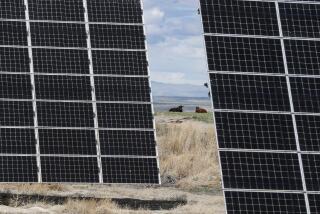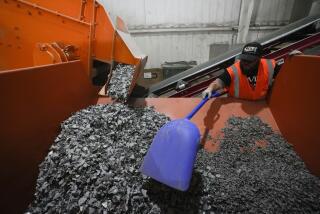From Trinkets to Giant Turbines, Solar Energy’s Future Appears Bright
- Share via
Solar energy is music to Malcolm S. Bru’s ears.
He sells solar-powered trinkets, including $25 music boxes that play “You Are My Sunshine” when held to the light. But few department store buyers will touch his wares, says Bru, market consultant for Aldermaston Sales of Locust Valley, N.Y. “They keep telling me that their customers don’t know what solar power is.”
Maybe so, but Bru isn’t about to give up.
He is rubbing elbows at the Anaheim Convention Center this week with the big boys of the solar industry. His tiny booth at the Renewable Energy Technologies Symposium & International Exposition is within eyeshot of industry behemoths such as General Electric and Arco, firms that have pumped millions of dollars into the solar market in recent years, developing big-ticket items such as solar generators and solar collector panels.
As the diversity of the exposition’s 275 exhibitors indicates, there is a renewed national interest in renewable energy--a source of power that is not dependent on fossil fuels. In Orange County alone, nearly 60 solar equipment dealers advertise their wares in the Yellow Pages. Organizers of the 3-year-old exposition, which runs through today, expect a record 12,000 visitors from 45 countries, mostly architects and contractors who want to view the current state of the industry.
As shown by the crowd count, interest in solar power is alive and well. But not all bodes well for the renewable energy industry. The current glut of oil on the market has led to some consumer apathy, and many legislators are equally blase, because federal tax credits for homeowners who install solar devices are not expected to be renewed in December.
Industry Growing
But renewable technologies now account for nearly 9% of the domestic energy supply, according to estimates from the federal Energy Department. And what was a million-dollar industry 10 years ago is today a multibillion-dollar industry, experts say.
And as the industry has grown, so have the names and titles of the people and companies behind it.
Twenty years ago, it was environmentalists who led the way. The movement spawned entrepreneurs who invented widgets and whatnots that harnessed sunlight or wind and converted the elements into useful energy. It didn’t take long, however, before corporations such as Exxon and Arco began gobbling up these entrepreneurial operations.
“It’s not the hippies that make up the marketplace any more, it’s the political conservatives,” said Michael Johnson, publisher of Solar Magazine.
Today, some of America’s biggest companies are the movers and shakers in alternative energy circles.
That is a welcome change from a decade ago, when a number of fly-by-night firms flooded the market with poor products that cooled many homeowners to solar heating, Johnson said. In the early days of the alternative energy movement, he said, some unscrupulous entrepreneurs were touting solar energy as a cure-all, and shady companies would entice customers with everything from free steak knives to television sets, slap some ill-designed solar panels atop a home, collect the money and skip town.
But today, both the buyers and sellers are far more sophisticated.
And homeowners are turning to solar energy in record numbers, industry officials say. Because of high interest rates, people are keeping their homes longer and instead are spending the dollars once reserved for new home purchases on improvements.
Among those improvements are an increasing number of solar heaters to help keep homes warm and energy costs down.
Sears, for example, now operates a solar division in Waco, Tex., installing solar hot water heaters in homes throughout the sunbelt.
Even companies such as Southern California Edison have gotten into the act. Currently, nearly 13% of the power sold by the company comes from alternative energy sources, including solar generating stations. By 1995, nearly 30% of Edison’s power will be supplied by these sources, according to Howard P. Allen, the company’s chairman and chief executive.
But the entrepreneurs are still at it.
One Santa Maria firm at the exhibition displayed its latest invention: a pyramid-shaped solar collector.
“The mobile home market is going crazy over these,” said Ken Vodraska, a sales representative for Solarcone Corp. He said his fiberglass collectors are light enough for mobile home rooftops and shaped to collect energy all day. “Besides that,” he said, “our collectors are very good looking.”
Other products on display at the show range from Bru’s music boxes to giant wind turbines selling for hundreds of thousands of dollars. Conference visitors also can pick up a straw safari hat with built-in solar-powered fan for a mere $69.95. And a $25, solar-powered baseball cap soon will be on the market, promised Larry Miller, president of Energy Sciences Inc. of Gaithersburg, Md.
More to Read
Inside the business of entertainment
The Wide Shot brings you news, analysis and insights on everything from streaming wars to production — and what it all means for the future.
You may occasionally receive promotional content from the Los Angeles Times.










